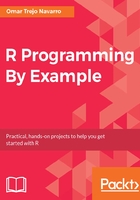
Working with data types and data structures
This section summarizes the most important data types and data structures in R. In this brief overview, we won't discuss them in depth. We will only show a couple of examples that will allow you to understand the code shown throughout this book. If you want to dig deeper into them, you may look into their documentation or some of the references pointed out in this chapter's introduction.
The basic data types in R are numbers, text, and Boolean values (TRUE or FALSE), which R calls numerics, characters, and logicals, respectively. Strictly speaking, there are also types for integers, complex numbers, and raw data (bytes), but we won't use them explicitly in this book. The six basic data structures in R are vectors, factors, matrices, data frames, and lists, which we will summarize in the following sections.